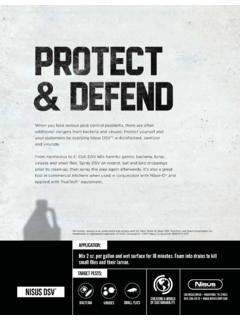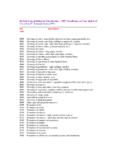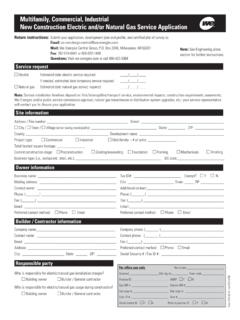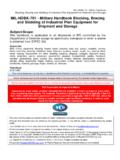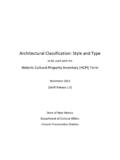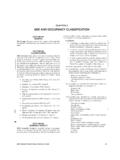Transcription of A Critical and Comprehensive Review of Boron in …
1 A Critical and Comprehensive Review of Boron in Wood preservation Mike H. Freeman Independent Wood Scientist Memphis, TN Craig R. McIntyre McIntyre Associates, Inc. Walls, MS Dick Jackson The Pacific Wood Preserving Companies Incline Village, NV ABSTRACT Borates have played an ever-increasing role in the preservation of wood worldwide and especially in the USA since the voluntary cancellation of CCA for residential lumber use patterns in 2004. However, there has not been a Review of the efficacy and performance of borates, especially Disodium Octaborate Tetrahydrate, outside of the AWPA Data Package submitted by Nicholas and Preston in 1988 and the Review by Drysdale in the IRG literature in 1994. The purpose of this publication is to have, in one location, the commonly referred to efficacy information on borates in wood preservation . Keywords: Borates, efficacy, performance, leaching, depletion, toxicity, corrosion, environmental INTRODUCTION - INORGANIC Boron Elemental Boron does not occur naturally, but combines with oxygen in a salt or ester of boric acid.
2 Over 200 borate minerals exist but very few are commercially significant. Borates are used in the manufacture of fiberglass insulation, detergents, fertilizers, flame retardants, and wood preservatives. Inorganic borates have been used as wood preservatives for many years. Boric acid and borax were the first two to be used as preservatives and were constituents of several Celcure mixtures patented in 1933 (Cockroft and Levy 1973). Borates available today offer a highly effective and flexible option for both stand alone and more specialized formulations and have received considerable attention in recent years. They include formulations prepared from sodium tetraborate, sodium pentaborate and boric acid, but the most common form is disodium octaborate tetrahydrate (DOT). DOT has the most widespread commercial use in North America (Groenier and Lebow 2006).
3 It has higher water solubility allowing the use of higher concentrations and increasing mobility in wood (Lebow 2007). The commercial potential of borate treatments was first identified in the 1930 s. Interest in standalone borates as wood preservatives first arose in Australia and New Zealand where borates were recommended for insect control (Drysdale 1994). The first industrial treatments were carried out in 1949 using rapidly diffusing borate mixtures. Boron treatment was approved for exterior, above ground use in New Zealand in 1958. Borates were previously viewed as ineffective because the chemical was not fixed in wood. This limited the development and acceptance, of borates treatments to specific end uses and timber commodities (Drysdale 1994). Over the last two decades researchers have refocused on Boron , due to the quest for a more operator and environmentally friendly, yet cost effective preservative (Barnes et al.)
4 , 1989; Drysdale 1994) with studies more focused on improvements to the application methods and inclusion of borates in remedial treatments. Research continues to develop borate formulations that have increased resistance to leaching while maintaining biocidal efficacy (Lake and McIntyre 2006, Robinson et al. 2005). Borates are durable, do not breakdown into ineffective products, do not evaporate and although soluble, they do not migrate far in soil (Currie 1997). Borate- treated wood is also odorless, colorless, and may be painted or stained. Today borates have gained worldwide acceptance in vacuum pressure treatments and envelope treatments to construction timber. More recently finished joinery treatments have been commercialized using double vacuum technology and is now of particular interest where concern against organic solvent preservatives is increasing (Schoeman and Lloyd 1998).
5 Current standards (AWPA 2008) allow for borates in above-ground environments protected from rain wetting. Due to their broad spectrum fungicidal and insecticidal action, borates are considered more effective than copper and zinc, with the later two performing better only because of their fixation in wood, not their inherent fungicidal activity (Lloyd et al. 2001). DISODIUM OCTABORATE TETRAHYDRATE (DOT) DOT is a stable, white, odorless, powdered chemical substance that is not flammable, combustible, or explosive and has low acute oral and dermal toxicity. The product itself is a flame retardant. It is sold under TIM-BOR ( ) and or BORA CARE (40% DOT in ethylene glycol) brands in the United States. SOLUBAR contains 98% DOT. DOT has a bulk density of 320- 480 kg/m3, a negligible vapor pressure at 20oC, solubility in water is at 20oC, at 50oC, melting point is 815oC, pH at 20oC is (3 % solution) and (10% solution) (MSDS 2007).
6 For ease of comparison, Boron compounds are often compared based on the Boric Acid Equivalent (BAE) which obviously is the amount of boric acid that could be formed from the subject compound. BAE is a standard unit of comparison of efficacy among borate compounds. Another standard unit of comparison that is typically used to express retentions in North America is B2O3 or as Boric Oxide. A last convention is that in Australasia where the retentions are expressed as per cent on a mass/mass basis where the denominator is the mass of oven dried wood. DOT has a higher solubility than borax and boric acid and contains more Boron or B2O3 than either per unit mass. Boric acid contains Boron , borax has while DOT (as TIMBOR) has Inorganic borates are diffusible, and with appropriate treating practices, can achieve excellent penetration in species that are difficult to treat with other preservatives.
7 However, the borate in the wood remains water soluble and hence they are standardized by the AWPA for only applications not directly exposed to liquid water. Typical examples of satisfactory building construction use of DOT would be studs, rafters, sill plates (Nicholas and Preston 1988). Typical timber uses are described as framing or flooring used in dry or damp conditions (Drysdale 1994). Strength test studies with borate treated wood shows that DOT does not degrade wood and in fact a slight increase in MOR values have been noted in borate treated wood (Nicholas and Preston 1988). In termite studies, Tokoro and Su (1993b) estimated the oral toxicities (LD50) of boric acid, TIM-BOR and BORA-CARE (40% DOT in ethylene glycol) and ethylene glycol (ca. 80% monoethylene and ca. 20% polyethylene glycol) and examined potential synergistic effects of the ethylene glycol in BORA-CARE against Coptotermes formosanus and Reticulitermes flavipes.
8 Boric acid is the least toxic for both termite species. Oral toxicities of BORA-CARE were significantly higher (LD50: g/g DOT and mg/g BAE) than TIM-BOR alone (LD50: g/g DOT and g/g BAE); indicating a potential synergism of DOT by ethylene glycol in BORA-CARE . Previous data indicated that the glycol carrier did not contribute significantly to the toxicity of the DOT/glycol mixture. Based on active ingredient DOT, BORA-CARE was approximately fold more toxic than TIM-BOR for both termite species. At the highest concentration of ethylene glycol used 27% (w/w) there was insignificant termite mortality, showing no termiticidal effect. Hence ethylene glycol synergized DOT but the reason for the synergy is unknown. Mechanism of action In biological applications, Boron is in the form of oxides as either boric acid or borates (Lloyd 1998). All borates convert to boric acid when they dissolve in acidic media such as in wood (pH 4-5).
9 Boric acid in a 1% solution contains B2O3; 1% borax contains B2O3 while DOT (TIMBOR) contains B2O3. Thus in treatment solutions one pound of DOT will deliver pound B2O3 which is equivalent to pound boric acid equivalent (BAE). In solution boric acid acts as a Lewis acid accepting an OH- to form the tetrahydroxyborate ion [B(OH)]-4. The toxicity and therefore protection of timber is due to the complexation of [B(OH)4-] with polyols of biological significance in both wood attacking fungi and insects. The polyol compounds of biological significance include vitamins, co-enzymes with the oxidized co-enzymes NAD+, NMN+, NADP thought to be the most likely target (Lloyd 1998). Boric acid forms very stable complexes by rapid esterification and this has an effect on extracellular substrates, intracellular substrates, and membranes resulting in altered metabolism, interference with electron transport which eventually synthesis of protein, ATP or DNA/ RNA synthesis.
10 The efficacy of Boron preparations depends mainly on the quantity of Boron that is applied to wood irrespective of whether borax, boric acid or DOT is used. Concentration used determines Boron content. To determine whether different borate salts elicit different responses in C. formosanus, workers were exposed to composite board samples of zinc borate, DOT, anhydrous boric acid and an untreated control. Activity and mortality data over 4 weeks suggested that the concentration of Boron in the wood, rather than the associated salt, has an impact on termite feeding, and that anhydrous boric acid reduces termite feeding more rapidly than the other formulations tested (Gentz and Grace 2007). It is important that the form and formulation of the applied Boron allows for the maximum production of free borate ions when in wood (Lloyd 1990; Lloyd 1998). In termites, borates act as a stomach poison.

